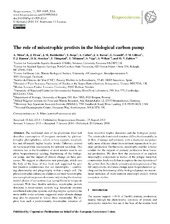| dc.contributor.author | Mitra, Aditee | eng |
| dc.contributor.author | Flynn, Kevin J. | eng |
| dc.contributor.author | Burkholder, Joann M. | eng |
| dc.contributor.author | Berge, Terje | eng |
| dc.contributor.author | Calbet, Albert | eng |
| dc.contributor.author | Raven, John A. | eng |
| dc.contributor.author | Granéli, Edna | eng |
| dc.contributor.author | Glibert, Patricia M. | eng |
| dc.contributor.author | Hansen, Per Juel | eng |
| dc.contributor.author | Stoecker, Diane K. | eng |
| dc.contributor.author | Thingstad, Tron Frede | eng |
| dc.contributor.author | Tillmann, Urban | eng |
| dc.contributor.author | Våge, Selina | eng |
| dc.contributor.author | Wilken, Susanne | eng |
| dc.contributor.author | Zubkov, Mikhail V. | eng |
| dc.date.accessioned | 2015-09-29T12:42:22Z | |
| dc.date.available | 2015-09-29T12:42:22Z | |
| dc.date.issued | 2014-02-20 | |
| dc.Published | Biogeosciences 2014, 11(4):995-1005 | eng |
| dc.identifier.issn | 1726-4170 | en_US |
| dc.identifier.uri | https://hdl.handle.net/1956/10533 | |
| dc.description.abstract | The traditional view of the planktonic food web describes consumption of inorganic nutrients by photoautotrophic phytoplankton, which in turn supports zooplankton and ultimately higher trophic levels. Pathways centred on bacteria provide mechanisms for nutrient recycling. This structure lies at the foundation of most models used to explore biogeochemical cycling, functioning of the biological pump, and the impact of climate change on these processes. We suggest an alternative new paradigm, which sees the bulk of the base of this food web supported by protist plankton communities that are mixotrophic – combining phototrophy and phagotrophy within a single cell. The photoautotrophic eukaryotic plankton and their heterotrophic microzooplankton grazers dominate only during the developmental phases of ecosystems (e.g. spring bloom in temperate systems). With their flexible nutrition, mixotrophic protists dominate in more-mature systems (e.g. temperate summer, established eutrophic systems and oligotrophic systems); the more-stable water columns suggested under climate change may also be expected to favour these mixotrophs. We explore how such a predominantly mixotrophic structure affects microbial trophic dynamics and the biological pump. The mixotroph-dominated structure differs fundamentally in its flow of energy and nutrients, with a shortened and potentially more efficient chain from nutrient regeneration to primary production. Furthermore, mixotrophy enables a direct conduit for the support of primary production from bacterial production. We show how the exclusion of an explicit mixotrophic component in studies of the pelagic microbial communities leads to a failure to capture the true dynamics of the carbon flow. In order to prevent a misinterpretation of the full implications of climate change upon biogeochemical cycling and the functioning of the biological pump, we recommend inclusion of multi-nutrient mixotroph models within ecosystem studies. | en_US |
| dc.language.iso | eng | eng |
| dc.publisher | Copernicus Publications | en_US |
| dc.rights | Attribution CC BY | eng |
| dc.rights.uri | http://creativecommons.org/licenses/by/3.0/ | eng |
| dc.title | The role of mixotrophic protists in the biological carbon pump | en_US |
| dc.type | Peer reviewed | |
| dc.type | Journal article | |
| dc.date.updated | 2015-07-28T12:38:46Z | |
| dc.description.version | publishedVersion | en_US |
| dc.rights.holder | Copyright 2014 The Authors | en_US |
| dc.identifier.doi | https://doi.org/10.5194/bg-11-995-2014 | |
| dc.identifier.cristin | 1169352 | |
| dc.subject.nsi | VDP::Matematikk og naturvitenskap: 400::Zoologiske og botaniske fag: 480::Marinbiologi: 497 | |
| dc.subject.nsi | VDP::Mathematics and natural scienses: 400::Zoology and botany: 480::Marine biology: 497 | |
| dc.subject.nsi | VDP::Matematikk og naturvitenskap: 400::Zoologiske og botaniske fag: 480::Økologi: 488 | |
| dc.subject.nsi | VDP::Mathematics and natural scienses: 400::Zoology and botany: 480::Ecology: 488 | |

